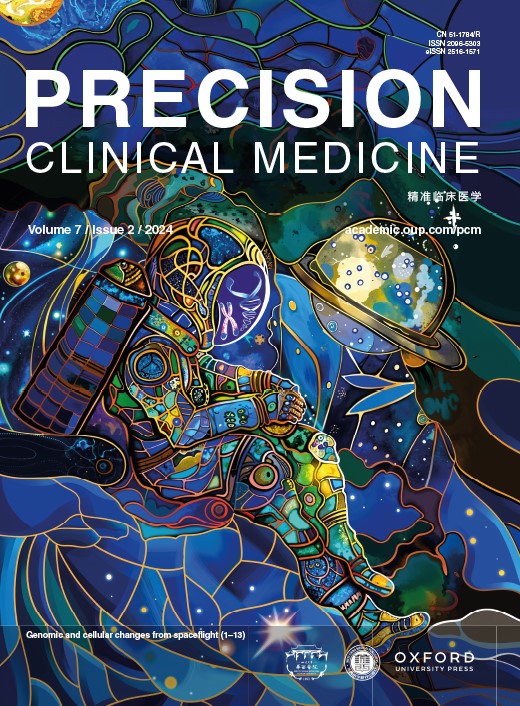基于人工智能的透明细胞肾细胞癌无创肿瘤分割、分级分层及预后预测。
IF 5.1
4区 医学
Q1 MEDICINE, RESEARCH & EXPERIMENTAL
Precision Clinical Medicine
Pub Date : 2023-08-17
eCollection Date: 2023-09-01
DOI:10.1093/pcmedi/pbad019
引用次数: 0
摘要
由于透明细胞肾细胞癌(clear-cell renal-cell carcinoma, ccRCC)复杂的组织病理特征,术前无创预后对选择合适的治疗方案至关重要。本研究共纳入来自4个独立患者队列的123445张计算机断层扫描(CT)图像进行分析。我们提出了一个使用级联框架进行深度学习分析的V瓶颈多分辨率和焦点器官网络(VB-MrFo-Net)。VB-MrFo-Net在肿瘤分割方面的表现优于VB-Net,其Dice评分为0.87。核级预测模型在logistic回归分类器中表现最好,曲线下面积在0.782 ~ 0.746之间。生存分析显示,我们的预测模型能够显著区分高生存风险患者,在普通队列中,风险比(HR)为2.49[95%置信区间(CI): 1.13-5.45, P = 0.023]。在Cancer Genome Atlas队列、Clinical Proteomic Tumor Analysis Consortium队列和Kidney Tumor Segmentation Challenge队列中,HRs分别为2.77 (95%CI: 1.58-4.84, P = 0.0019)、3.83 (95%CI: 1.22-11.96, P = 0.029)和2.80 (95%CI: 1.05-7.47, P = 0.025)。总之,我们提出了一种新的VB-MrFo-Net用于肾肿瘤的分割和ccRCC的自动诊断。该风险分层模型可根据术前无创CT图像准确区分肿瘤分级高、生存风险高的患者,为治疗方案的选择提供实用建议。本文章由计算机程序翻译,如有差异,请以英文原文为准。
Artificial intelligence-based non-invasive tumor segmentation, grade stratification and prognosis prediction for clear-cell renal-cell carcinoma.
Abstract Due to the complicated histopathological characteristics of clear-cell renal-cell carcinoma (ccRCC), non-invasive prognosis before operative treatment is crucial in selecting the appropriate treatment. A total of 126 345 computerized tomography (CT) images from four independent patient cohorts were included for analysis in this study. We propose a V Bottleneck multi-resolution and focus-organ network (VB-MrFo-Net) using a cascade framework for deep learning analysis. The VB-MrFo-Net achieved better performance than VB-Net in tumor segmentation, with a Dice score of 0.87. The nuclear-grade prediction model performed best in the logistic regression classifier, with area under curve values from 0.782 to 0.746. Survival analysis revealed that our prediction model could significantly distinguish patients with high survival risk, with a hazard ratio (HR) of 2.49 [95% confidence interval (CI): 1.13–5.45, P = 0.023] in the General cohort. Excellent performance had also been verified in the Cancer Genome Atlas cohort, the Clinical Proteomic Tumor Analysis Consortium cohort, and the Kidney Tumor Segmentation Challenge cohort, with HRs of 2.77 (95%CI: 1.58–4.84, P = 0.0019), 3.83 (95%CI: 1.22–11.96, P = 0.029), and 2.80 (95%CI: 1.05–7.47, P = 0.025), respectively. In conclusion, we propose a novel VB-MrFo-Net for the renal tumor segmentation and automatic diagnosis of ccRCC. The risk stratification model could accurately distinguish patients with high tumor grade and high survival risk based on non-invasive CT images before surgical treatments, which could provide practical advice for deciding treatment options.
求助全文
通过发布文献求助,成功后即可免费获取论文全文。
去求助
来源期刊

Precision Clinical Medicine
MEDICINE, RESEARCH & EXPERIMENTAL-
CiteScore
10.80
自引率
0.00%
发文量
26
审稿时长
5 weeks
期刊介绍:
Precision Clinical Medicine (PCM) is an international, peer-reviewed, open access journal that provides timely publication of original research articles, case reports, reviews, editorials, and perspectives across the spectrum of precision medicine. The journal's mission is to deliver new theories, methods, and evidence that enhance disease diagnosis, treatment, prevention, and prognosis, thereby establishing a vital communication platform for clinicians and researchers that has the potential to transform medical practice. PCM encompasses all facets of precision medicine, which involves personalized approaches to diagnosis, treatment, and prevention, tailored to individual patients or patient subgroups based on their unique genetic, phenotypic, or psychosocial profiles. The clinical conditions addressed by the journal include a wide range of areas such as cancer, infectious diseases, inherited diseases, complex diseases, and rare diseases.
 求助内容:
求助内容: 应助结果提醒方式:
应助结果提醒方式:


